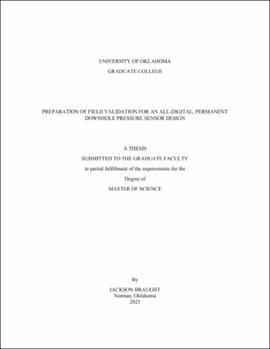| dc.description.abstract | Downhole pressure sensing has become increasingly important in oil and gas operations. Some of the many advancements provided by an improvement in downhole sensing is seen in drilling, stimulation, production forecasting, and wellbore integrity. Currently, downhole pressure sensors on the market are costly, cannot be distributed throughout a wellbore, and have a limited lifespan. As a result, a low-cost, all-digital downhole pressure sensor for permanent, distributed installation is being proposed. The planned sensor will measure pressure up to 10,000 psi with a temperature limit of 250°C. The objective for this study was to design the pressure system, validate the sensor under downhole pressure and temperature conditions in a laboratory apparatus, and to prepare a field validation test of the sensor system.
The pressure housing was designed as a cylinder steel tube surrounding the actual sensor while maintaining a limited outer footprint to withstand the required temperature and pressure. Two different end caps were developed. The first cap was developed to allow fluid flow to the sensor system within the housing without damaging the sensor itself. The second cap was designed to allow the sensor's electrical requirements and pressure reading to be transmitted from the surface to the sensor and vice versa without fluid penetrating the housing. The housing pressure and temperature ratings were validated with finite element modeling. Laboratory tests was performed and showed the pressure sensors behaved as expected. A field installation plan was prepared for installing the sensor in a wellbore. The sensor and reference gauge was successfully placed at a depth of 2,550 feet, run the connection lines for the sensor and reference gauge from the placement depth to the surface and connected them to their respective surface acquisition systems, and sealed the wellbore at the surface at 1.5x hydrostatic pressure about 1,300 psi. A workover rig and crew were used to lower the system into the wellbore and install the wellhead, while a hot oiler truck was used to pressure the wellbore through the wellhead design. Three cyclic pressure tests were conducted, and a drift test of two weeks was successfully done. The field test showed that the sensor was operating within specifications and showed no drift. After the test, we examined the sensors out of the wellbore. There are no signs of leakage; the sensor still functions well. | en_US |
